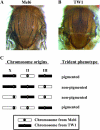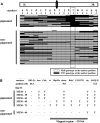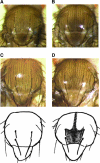Natural variation of ebony gene controlling thoracic pigmentation in Drosophila melanogaster
- PMID: 17660557
- PMCID: PMC2034628
- DOI: 10.1534/genetics.107.075283
Natural variation of ebony gene controlling thoracic pigmentation in Drosophila melanogaster
Abstract
We identified the causal genetic variation for the difference in the thoracic trident pigmentation intensity between two wild-derived strains of Drosophila melanogaster. It was found to be the difference in expression level of ebony, which codes for an enzyme in the melanin-synthesis pathway and has pleiotropic effects on vision and behavior.
Figures




Similar articles
-
Divergent enhancer haplotype of ebony on inversion In(3R)Payne associated with pigmentation variation in a tropical population of Drosophila melanogaster.Mol Ecol. 2011 Oct;20(20):4277-87. doi: 10.1111/j.1365-294X.2011.05260.x. Epub 2011 Sep 13. Mol Ecol. 2011. PMID: 21914015
-
Complex patterns of cis-regulatory polymorphisms in ebony underlie standing pigmentation variation in Drosophila melanogaster.Mol Ecol. 2015 Dec;24(23):5829-41. doi: 10.1111/mec.13432. Epub 2015 Nov 20. Mol Ecol. 2015. PMID: 26503353
-
Pigmentation and behavior: potential association through pleiotropic genes in Drosophila.Genes Genet Syst. 2013;88(3):165-74. doi: 10.1266/ggs.88.165. Genes Genet Syst. 2013. PMID: 24025245 Review.
-
The molecular genetics of clinal variation: a case study of ebony and thoracic trident pigmentation in Drosophila melanogaster from eastern Australia.Mol Ecol. 2011 May;20(10):2100-10. doi: 10.1111/j.1365-294X.2011.05089.x. Epub 2011 Apr 5. Mol Ecol. 2011. PMID: 21466604
-
The Genetic Basis of Pigmentation Differences Within and Between Drosophila Species.Curr Top Dev Biol. 2016;119:27-61. doi: 10.1016/bs.ctdb.2016.03.004. Epub 2016 Apr 25. Curr Top Dev Biol. 2016. PMID: 27282023 Free PMC article. Review.
Cited by
-
Genetic basis of sex-specific color pattern variation in Drosophila malerkotliana.Genetics. 2008 Sep;180(1):421-9. doi: 10.1534/genetics.108.091728. Epub 2008 Aug 24. Genetics. 2008. PMID: 18723880 Free PMC article.
-
Adaptation to local ultraviolet radiation conditions among neighbouring Daphnia populations.Proc Biol Sci. 2011 May 7;278(1710):1306-13. doi: 10.1098/rspb.2010.1663. Epub 2010 Oct 13. Proc Biol Sci. 2011. PMID: 20943691 Free PMC article.
-
Transcriptome analysis reveals novel patterning and pigmentation genes underlying Heliconius butterfly wing pattern variation.BMC Genomics. 2012 Jun 29;13:288. doi: 10.1186/1471-2164-13-288. BMC Genomics. 2012. PMID: 22747837 Free PMC article.
-
Unraveling the Tangled Skein: The Evolution of Transcriptional Regulatory Networks in Development.Annu Rev Genomics Hum Genet. 2015;16:103-31. doi: 10.1146/annurev-genom-091212-153423. Epub 2015 May 20. Annu Rev Genomics Hum Genet. 2015. PMID: 26079281 Free PMC article. Review.
-
Reconciling Differences in Pool-GWAS Between Populations: A Case Study of Female Abdominal Pigmentation in Drosophila melanogaster.Genetics. 2016 Feb;202(2):843-55. doi: 10.1534/genetics.115.183376. Epub 2015 Dec 29. Genetics. 2016. PMID: 26715669 Free PMC article.
References
-
- Adams, M. D., S. E. Celniker, R. A. Holt, C. A. Evans, J. D. Gocayne et al., 2000. The genome sequence of Drosophila melanogaster. Science 287: 2185–2195. - PubMed
-
- Gibert, P., B. Moreteau and J. R. David, 2000. Developmental constraints on an adaptive plasticity: reaction norms of pigmentation in adult segments of Drosophila melanogaster. Evol. Dev. 2: 249–260. - PubMed
-
- Gibert, P., P. Capy, A. Imasheva, B. Moreteau, J. P. Morin et al., 2004. Comparative analysis of morphological traits among Drosophila melanogaster and D. simulans: genetic variability, clines and phenotypic plasticity. Genetica 120: 165–179. - PubMed
Publication types
MeSH terms
Substances
Associated data
- Actions
- Actions
LinkOut - more resources
Full Text Sources
Molecular Biology Databases

